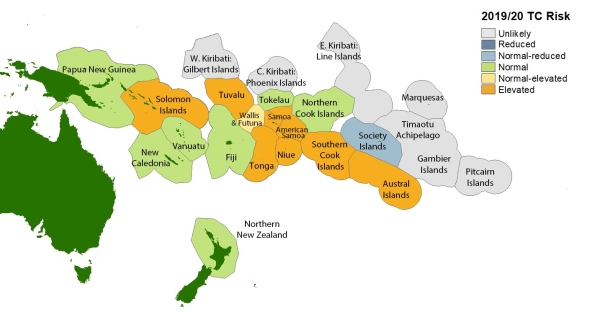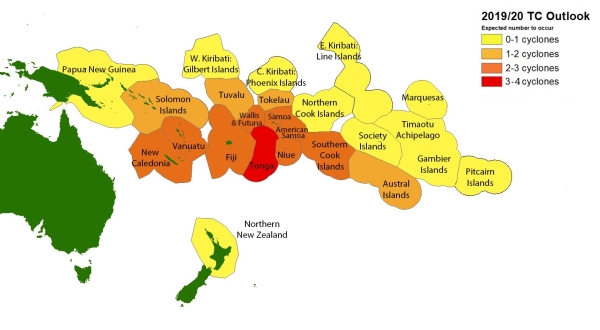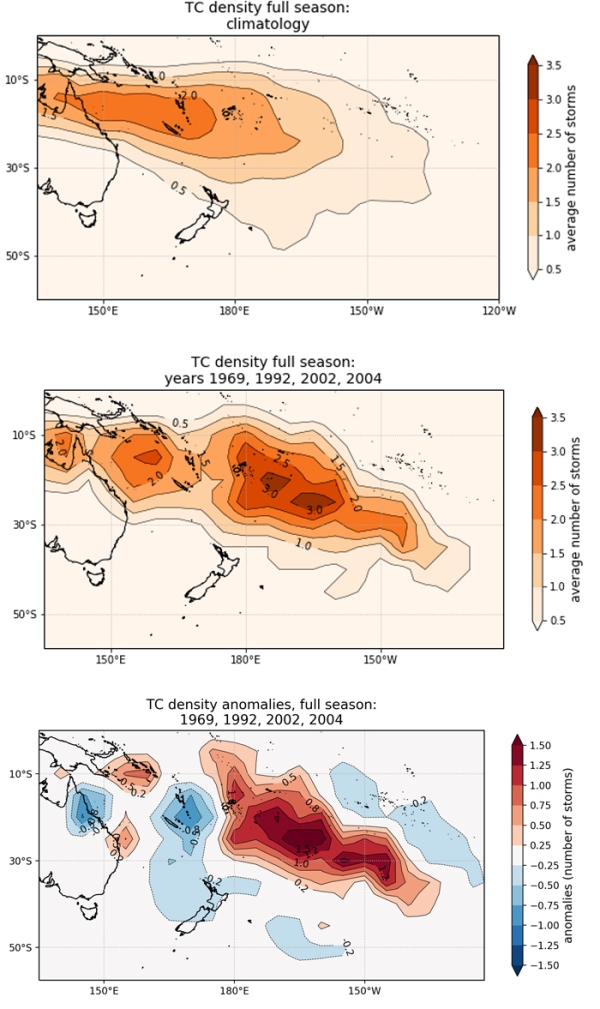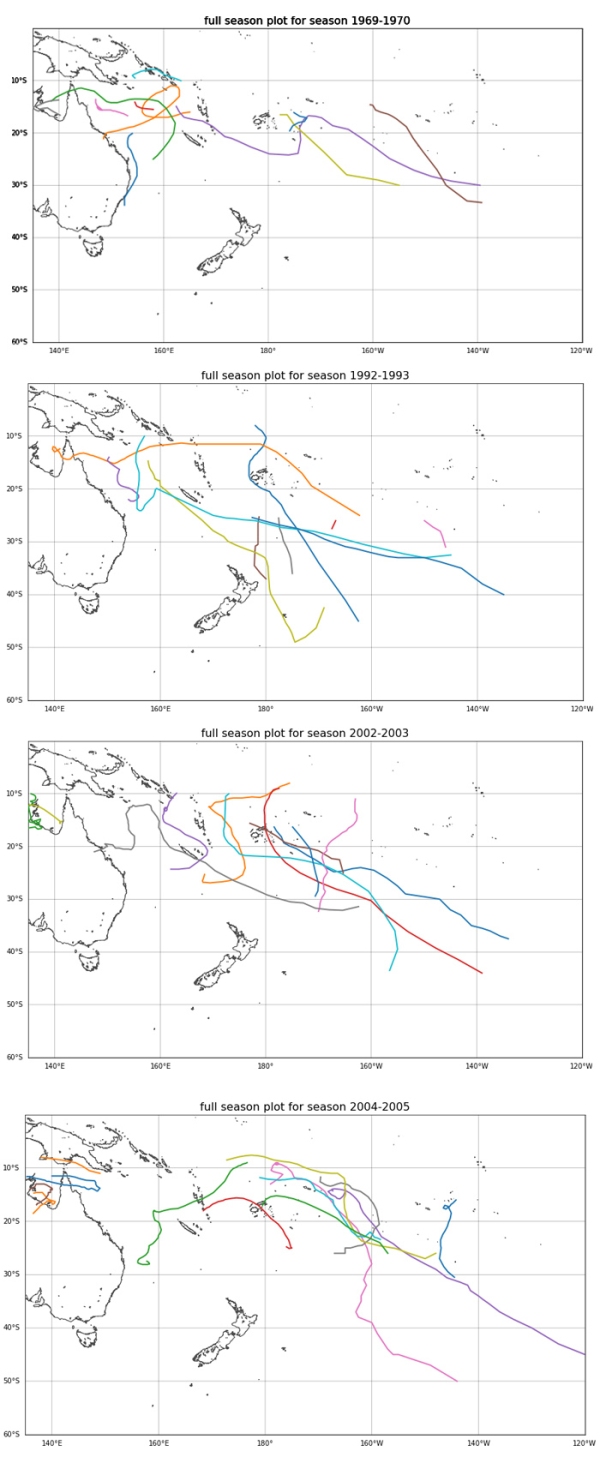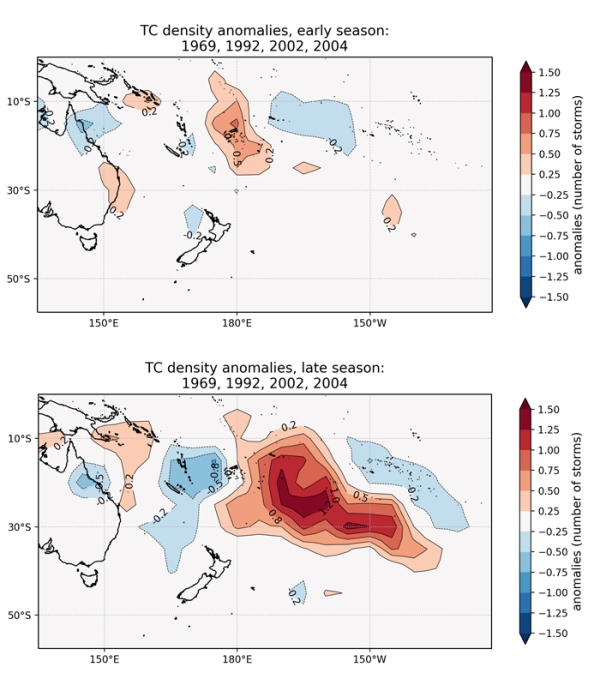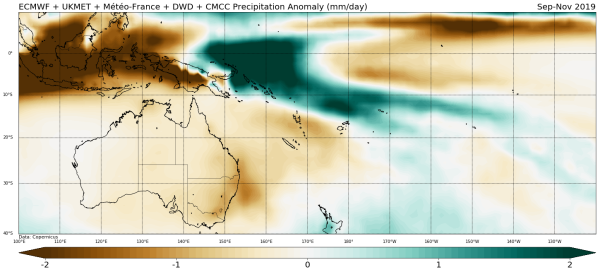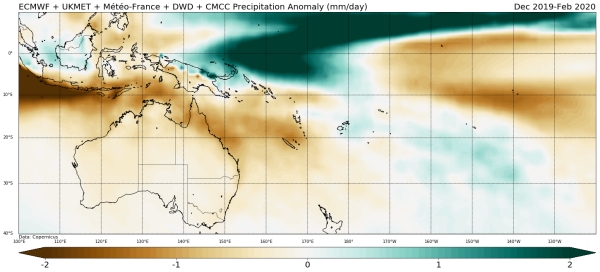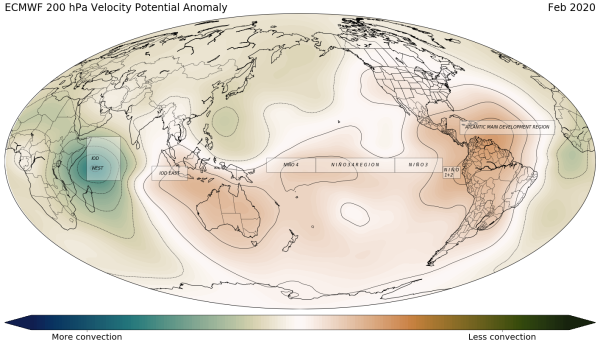NIWA and MetService analyses indicate 9 to 12 named tropical cyclones (TC) could occur in the Southwest Pacific basin between November 2019 and April 2020. This expectation for tropical cyclone activity is close to normal for the region, but with elevated activity east of the International Date Line especially during the late season between February and April.
Tropical cyclones have a significant impact across the Southwest Pacific, with the season officially starting in November and lasting until the end of April.
Vanuatu and New Caledonia typically experience the greatest TC activity, with an average of about two or three named cyclones passing close to those islands each year. For this season, the expectation for those two islands is normal, while Wallis & Futuna, Tuvalu, Fiji, Samoa, American Samoa, Niue, Tonga and the Southern Cook Islands may experience two or more cyclones. Four severe cyclones reaching Category 3 or higher might occur anywhere across the region.
On average, at least one ex-tropical cyclone passes within 550km of New Zealand each year. For the coming season, the risk for an ex-tropical cyclone affecting New Zealand is considered near normal. If an ex-tropical cyclone comes close to the country, it is more likely to pass east of the North Island, and landfall of a degrading storm system is possible. Significant rainfall, extreme winds, hazardous marine conditions and coastal damage can occur leading up to and during these events.
At present, sea surface temperature anomalies across the central Pacific are warm (positive), while the eastern equatorial Pacific Ocean is cool (negative). Atmospheric circulation patterns over French Polynesia and northern Australia indicate ENSO (El Niño-Southern Oscillation) neutral conditions, but are leaning toward El Niño. Oceanic and atmospheric forecasts for ENSO indicate neutral conditions for the TC season are most likely, with lower probabilities that some type of El Niño may develop by mid-summer. It is worth noting that if El Niño develops it may be of the Modoki type (central Pacific-based) during summer.
There is no expectation that there will be any reduction from normal tropical cyclone activity for the coming season. Increased TC activity is expected for several islands east of the International Date Line, including Samoa, American Samoa, Tonga, Niue the southern Cook Islands, and especially near the Austral Islands.
Tropical cyclones are categorised in strength from 1 to 5, with 5 being the most intense. For the coming season, about four storms are anticipated to reach at least Category 3 strength, with mean wind speeds of at least 118 km/h winds.
Past years with conditions similar to present suggest several storms that develop could intensify to at least Category 3 strength. Category 5 strength cyclones, where wind gusts exceed 199 km/h, have occurred in some years with similar conditions leading into the 2019/20 season (known as ‘analogue’ seasons). Therefore, all communities should remain alert and well-prepared for severe events.
New Zealand should also remain vigilant as the season unfolds. During some analogue seasons used in the preparation of this seasonal outlook, multiple ex-tropical cyclones passed within 550 km of the country. Significant wind, waves and rainfall are possible from ex-tropical cyclone interactions. Their effects can be spread over a large area, particularly if the decaying storm system of tropical origin interacts with separate weather systems embedded in the middle latitudes.
All communities, regardless of changes in TC risk, should remain vigilant and be aware if the regional climate situation (including ENSO) changes. As with most years, TC activity is expected to increase during the second half of the season from February-April. Early season TC activity is expected to be near normal.
NIWA, MetService, MeteoFrance, BoM, NOAA and Pacific Island National Meteorological Services will all continue to track the progression of ENSO and TC activity, with an update to this guidance in January 2020 if needed.
It does not take a direct hit or a severe cyclone to cause significant damage or life-threatening weather. When dangerous weather is forecast, please heed the advice of your local civil defence or disaster management offices.
Contacts
In New Zealand:
Mr. Ben Noll, Meteorologist, NIWA Tel: +64 9 375 6334
Mr. Chris Noble, Manager, Severe Weather Services TCWC (Tropical Cyclone Warning Centre) Wellington MetService New Zealand Tel: +64 4 470 1175
Ms. Nava Fedaeff, Forecaster/Science Communicator, NIWA Tel: +64 9 375 6337
In the Pacific Islands, please contact your local national meteorological service for information about how this guidance should be interpreted.
For Australia and associated offshore islands, please contact the Australian Bureau of Meteorology for information about how this guidance should be interpreted.
For French Polynesia, Wallis, Futuna and New Caledonia, please contact MeteoFrance regional offices for information about how this guidance should be interpreted.
New Zealand’s National Institute of Water & Atmospheric Research (NIWA) and Meteorological Service of New Zealand (MetService) formulated this seasonal tropical cyclone outlook, along with contributions from meteorological forecasting organizations from the Southwest Pacific, the Australian Bureau of Meteorology, MeteoFrance and the Pacific Island National Meteorological Services.
Additional background information
Modern analogue guidance
TCs in the Southwest Pacific usually develop between November and April, but occasionally they can occur in October and May, very rarely in June – August. An analysis of past TC tracks in the SW Pacific indicate they are exceptionally unlikely in September, although one system recently formed during this time. Peak TC season is usually from January to March.
Based on seasons with similar background climate conditions to the present, TC activity is expected to be elevated around the Coral Sea near the central Queensland coastline, the Solomon Islands, and Tuvalu, while east of the International Date Line risk is also elevated near Wallis & Futuna, Samoa, American Samoa, Tonga, Niue, the southern Cook Islands and the Austral Islands. On average, nearly half of the TCs that developed since the 1969-70 season have reached hurricane force with mean wind speeds of at least 64 knots (118 km/h).
To find past analogues that describe the climate state leading into the upcoming TC season, the past May-September conditions were examined for the tropical Pacific from 1969 to the present. For most of winter and early spring 2018, the ENSO system was leaning weakly toward an ocean-predominant ENSO state (termed NINO3.4 NINO), followed by a decline to neutral conditions by September. Available information from international forecasting centres that issue global climate forecast model outputs and ENSO diagnostics are integrated by NIWA’s National Climate Atmosphere and Hazards Centre. The collective guidance suggests ENSO neutral is most likely (45-55% chance), with the likelihood of El Niño conditions being more moderate (35-40% chance) across the season. If El Niño does develop, it is expected that a Modoki-style event could form by the late summer season. As such, an additional element used to select the TC analogue seasons also included years when ENSO conditions during November-April were neutral or reminiscent of weak El Niño.
We used a joint ENSO index that combines the Southern Oscillation Index (SOI) with the most widely-used oceanic index of sea surface temperature anomalies in the equatorial central-western Pacific (NINO3.4). This joint ENSO index is described in Gergis and Fowler (2005) as the “Coupled ENSO Index” (CEI). Using the CEI, we selected analogue TC seasons for the 2019-20 forecast. We highlighted seasons when the equatorial SSTs and the SOI were indicative of a transition from ocean-predominant ENSO conditions in winter-spring to neutral or weak-to-moderate El Niño conditions during summer-autumn.
Four analogue TC seasons (1969/70; 1992/93; 2002/03; 2004/05) typified the antecedent ENSO development and our expectations for the coming season based on international ENSO forecasts. Note that the selection of analogue seasons relates to the high-quality TC data period in the satellite era beginning in 1969/70 (only 49 seasons), the availability of TC track data (current only to the end of the 2017/18 season), and the limited number of similar analogues to this season. As such, the tropical cyclone guidance for November 2019 to April 2020 is built on the four analogue seasons identified above.
NIWA’s SW Pacific TC outlook spans four areas of responsibility overseen by international monitoring and forecast agencies (RMSC Nadi, TCWC Brisbane, TCWC Port Moresby and TCWC Wellington). We used a high-quality set of past TC tracks from the International Best Tracks Archive for Climate Stewardship (IBTRACS) which covers 135°E to 120°W longitude to draw on past TC track patterns for this seasonal outlook. This region encompasses a basin that is defined by climatology rather than geopolitical or meteorological boundaries (Diamond et al., 2012). Elevated activity is expected in the Coral Sea off the coast of central Queensland, near the Solomon Islands and Tuvalu, while east of the International Date Line elevated risk includes Samoa, American Samoa, Tonga, Niue, the southern Cook Islands and the Austral Islands (Table 1; Figure 2 & 3). Normal or above normal activity is expected for Wallis & Futuna. All other areas are expected to experience near normal risk for seasonal TC activity, with the exception of the Society Islands which are expected to experience normal or below normal activity. The main TC genesis region is expected to lie within a band between 10 – 12°S (north of Vanuatu) to the west of the International Date Line, with elevated risk of storms tracking east of the International Date Line during the late season. All of the analogue seasons we have identified experienced a minimum of three severe cyclones (≥ Category 3 scale), and two of the four analogue years experienced at least one Category 5 tropical cyclone. A total of 11 named storms are expected this coming season (spread of 9-12 based on past analogues), which is close to normal.
A split of the analogue TC seasons into early (November – January) and late (February – April) periods suggests TC activity will be close to normal for the early part of the TC season (Figure 4). Activity in general is expected to increase during the late season, especially for islands east of the International Date Line. The spatial anomalies for this TC outlook strongly indicate increased risk of storms occurring near Samoa, American Samoa, Tonga, Niue, the Southern Cook Islands and the Austral Islands.
Previous TC research has indicated storm track sinuosity increases during El Niños (Philip Malsale, 2011). This means that some tropical cyclone tracks for the coming season, if El Niño arises, may have more wandering trajectories than normal. TC intensity is partly related to how long developing cyclonic systems reside in the tropics and gain support for their growth from underlying warm waters. In addition, the subtropical jet and South Pacific Convergence Zone (SPCZ) mutually interact and contribute to shear (which can disorganise storm systems) during extra-tropical transition.
The interplay of hemispheric-scale atmospheric circulation with the timing of short-term Madden-Julian Oscillation (MJO) activity on a 30 to 50-day cycle has significant bearing on regional TC activity. Increased frequency and more intense TC activity can be expected during the MJO 6-7 paired phase (Diamond and Renwick, 2015). Weekly statistical forecasts of TC genesis and TC activity for the SW Pacific basin are produced by MeteoFrance based on phasing of the MJO (Leroy and Wheeler, 2008). This guidance is useful for sub-seasonal regional tropical cyclone guidance (see http://www.meteo.nc/espro/previcycl/cyclA.php.) Real-time MJO monitoring is also available from the Australian Bureau of Meteorology at http://www.bom.gov.au/climate/mjo/.
TC tracks for past seasons similar to our expectations covered a zone flanking the International Date Line (~165°E – 165°W) during extra-tropical transition (ETT) exiting the tropics at 25°S latitude (Diamond et al., 2013). For the historical TC tracks in the seasons we have selected as analogues, there is a very large spread for the location where each system underwent ETT that presents significant uncertainties for maritime navigation risks.
Previous work indicates New Zealand interacts with at least one ex-tropical cyclone passing within 550 km of the country every year on average (Lorrey et al., 2014). Some years there are none, while in other years there are more than one. For the coming TC season, the risk for New Zealand is normal. We identified two ex-tropical cyclones using four analogue seasons in this outlook that passed close to New Zealand, which gives a rounded average of about 1 storm per year. The historic ex-tropical cyclones selected for this outlook that passed close to New Zealand tracked offshore to the east of the North Island (see Figure 3).
Dynamical climate model guidance summary
There is model agreement for average or below average sea surface temperatures (SSTs) extending from the Gulf of Carpentaria to the Coral Sea during the first half of the tropical cyclone season (November 2019-January 2020). During the second half of the season, near or above average SSTs are also possible. SSTs are projected to be above average from eastern Papua New Guinea to southeast of Fiji. Near average SSTs are forecast for the remainder of the basin.
There is strong agreement among the models for below normal rainfall east and northeast of Samoa as well as west of Vanuatu (Figure 5 & 6). An area of above normal rainfall, along the South Pacific Convergence Zone (SPCZ) is forecast to extend from far eastern Papua New Guinea southeast to near Fiji to about 150˚W. This region of above normal rainfall is well aligned with the climatological, or average, position of the SPCZ where enhanced convection, showers and thunderstorms normally occur.
This predicted SST and rainfall distribution suggests a more active SPCZ than normal is possible from eastern Papua New Guinea to near and southeast of Fiji.
Forecast 200 hPa velocity potential, or large scale atmospheric vertical motion, is forecast to favour sinking air (positive anomaly) over the eastern Indian Ocean and east-central tropical Pacific Ocean (Figure 7). While a significant signal for large scale vertical motion (negative anomaly) is absent, it is possible that there will be a region between those two positive anomalies where increased convergence, disturbance and rising air could be favoured. In addition, 200 hPa velocity potential is forecast to slightly favour enhanced vertical motion from Papua New Guinea to the Solomon Islands from December 2019 onward.
Mean sea level pressure (MSLP) is forecast to be normal or above normal for much of the season across the Gulf of Carpentaria and Coral Sea, as influenced by a positive Indian Ocean dipole event. Normal or below normal MSLP is projected east of Papua New Guinea, extending southeast to Fiji.
References
Gergis, J., and A. M. Fowler, 2005. Classification of synchronous oceanic and atmospheric El Niño–Southern Oscillation (ENSO) events for palaeoclimate reconstruction. International Journal of Climatology, 25: 1541–1565.
Diamond, H.J., and J.A. Renwick, 2015. The climatological relationship between tropical cyclones in the southwest Pacific and the Madden-Julian Oscillation. International Journal of Climatology, 35: 676-686. doi: 10.1002/joc.4012.
Diamond, H.J., A.M. Lorrey, K.R. Knapp, and D.H. Levinson, 2012. Development of an enhanced tropical cyclone tracks database for the southwest Pacific from 1840-2011. International Journal of Climatology, 32: 2240–2250. doi:10.1002/joc.2412.
Diamond, H.J., A.M. Lorrey, and J.A. Renwick, 2013. A Southwest Pacific tropical cyclone climatology and linkages to the El Niño–Southern Oscillation. Journal of Climate, 26(1): 3-25. doi:10.1175/JCLI-D-12-00077.1.
Leroy, A., and M.C. Wheeler, 2008. Statistical prediction of weekly tropical cyclone activity in the Southern Hemisphere. Monthly Weather Review, 136: 3637-3654.
Lorrey, A.M., G. Griffiths, N. Fauchereau, H.J. Diamond, P.R. Chappell, and J. Renwick, 2014. An ex-tropical cyclone climatology for Auckland, New Zealand. International Journal of Climatology, 34: 1157–1168. doi: 10.1002/joc.3753.
Malsale, P. 2011. Analysis of tropical cyclone track sinuosity in the South Pacific region using ARCGIS. Unpublished MSc Thesis, University of the South Pacific, 155 Pages.
Table 1: The average number of TCs passing close to the main South Pacific Island groups between November and April. The activity associated with some island groups for the coming season is a subjective assessment, and has been stated to be consistent with the wishes of the national meteorological services involved in generating this regional forecast. In addition, subjective qualification of activity (and associated risk) also recognises the small differences between the actual TC counts for the analogue composites and climatological values. The table is therefore only generally indicative of how many storms might be expected for any given island group for the coming season.
|
Country/ |
Climatology |
Analogue seasons |
Anomaly |
% Difference |
Risk |
|
Territory |
|
|
|
|
|
|
Tonga |
2.2 |
3.2 |
1 |
45 |
Elevated |
|
Fiji |
2.5 |
3.0 |
0.5 |
20 |
Normal |
|
Wallis & Futuna |
2.2 |
2.7 |
0.5 |
25 |
Normal-elevated |
|
American Samoa |
1.7 |
2.7 |
1 |
60 |
Elevated |
|
Niue |
1.8 |
2.6 |
0.8 |
45 |
Elevated |
|
Samoa |
1.7 |
2.5 |
0.8 |
50 |
Elevated |
|
Vanuatu |
2.9 |
2.4 |
-0.5 |
-20 |
Normal |
|
S. Cooks |
1.3 |
2.3 |
1 |
75 |
Elevated |
|
New Caledonia |
2.75 |
2.2 |
-0.55 |
-20 |
Normal |
|
Tuvalu |
1.4 |
2.0 |
0.6 |
45 |
Elevated |
|
Solomon Is. |
1.2 |
1.8 |
0.6 |
50 |
Elevated |
|
Austral Is. |
0.75 |
1.8 |
1 |
135 |
Elevated |
|
Tokelau |
1.6 |
1.6 |
0 |
0 |
Normal |
|
Papua New Guinea |
0.9 |
0.9 |
0 |
0 |
Normal |
|
N. New Zealand |
0.75 |
0.7 |
-0.05 |
-10 |
Normal |
|
Society Is. |
0.7 |
0.5 |
-0.2 |
-30 |
Normal-reduced |
|
N. Cooks |
0.5 |
0.5 |
0 |
0 |
Normal |
|
Tuamotu |
0.2 |
0.1 |
-0.1 |
-50 |
Unlikely |
|
W. Kiribati |
0.1 |
0.1 |
0 |
0 |
Unlikely |
|
Marquesas |
0.1 |
0.1 |
0 |
0 |
Unlikely |
|
Pitcairn |
0 |
0.0 |
0 |
0 |
Unlikely |
|
C. Kiribati |
0 |
0.0 |
0 |
0 |
Unlikely |
|
E. Kiribati |
0 |
0.0 |
0 |
0 |
Unlikely |
Table 2: Previous analogue seasons and intensity of TCs and storms that occurred in the Southwest Pacific during the November-April TC season. Categorisation of storms aligns to the Australia Bureau of Meteorology (BoM) scale.
|
Season |
Number of named storms |
Right: TC category (BoM scale) |
Cat 1 |
Cat 2 |
Cat 3 |
Cat 4 |
Cat 5 |
|
1969/70 |
9 |
4 |
2 |
3 |
0 |
0 |
|
|
1992/93 |
12 |
2 |
2 |
5 |
3 |
0 |
|
|
2002/03 |
12 |
3 |
2 |
2 |
1 |
4 |
|
|
2004/05 |
11 |
4 |
0 |
2 |
1 |
4 |
|
|
Mean total |
11 |
3.25 |
1.5 |
3 |
1.25 |
2 |
|
|
Rounded mean totals |
11 |
3 |
2 |
3 |
1 |
2 |
Analogue guidance summary:
Based on the guidance NIWA has generated, a conservative range of 9-12 named TCs could be expected for the 2019-20 season for the Southwest Pacific basin (135° E – 120° W). The spread for the estimated storm activity comes from the variation between four selected analogue seasons. The historic average is just over 10 named cyclones per season for the basin. There is relatively low disagreement between the analogues for number of storms for this season and the potential outcomes across the SW Pacific islands.
Potentially, a combination of up to six cyclones may reach category 3 or higher status. The long-term TC climatology and the analogues we have identified suggests the high likelihood that a Category 5 system may occur (see Table 2), with two of the historic analogue seasons indicating more than one storm of this magnitude could occur. All the historic analogues selected for the 2019-20 outlook indicate multiple severe TCs equivalent or greater than Category 3 occurred in seasons similar to the present (at least 3 in each season). This provides confidence in the statistical outlook for expected storm strengths.
For the selected analogues, two of the four years show at least one ex-tropical cyclone came within 550 km of New Zealand. The rounded average interaction for New Zealand is 1 named storm per season. Some of the decaying systems were also associated with high rainfall, damaging winds and amplified coastal wave conditions. The risk of an interaction for New Zealand (at least one storm coming within 550 km of the country) for the 2019-20 season is near normal. There is an equal probability of a decaying ex-tropical cyclone tracking to the east or west of the North Island.
Dynamical Guidance Summary
A synthesis of model atmospheric and SST guidance favour near average tropical cyclone activity for the 2019-20 Southwest Pacific tropical cyclone season. However, there will likely be regional differences with normal or below normal tropical cyclone activity likely for far western (Gulf of Carpentaria) and far eastern areas of the basin (northern Cook Islands, Marquesas, Tuamotu archipelago, and Society Islands). Normal or above normal activity is forecast to extend from eastern Papua New Guinea southeast to near Fiji, including the Solomon Islands and Vanuatu, which is consistent with analogue guidance.
ECMWF seasonal guidance, October 2019-March 2020
Tropical Cyclone Density (category 1 and 2): ECMWF seasonal guidance signals reduced tropical storm density for parts of the Gulf of Carpentaria and Coral Sea, with near normal density elsewhere.
Hurricane/Severe Tropical Cyclone Frequency (category 3 or higher): ECMWF seasonal guidance supports a reduction in the overall number of severe tropical numbers. However, this does not reduce the risk for any one region being impacted by a severe tropical cyclone
Accumulated cyclone energy (ACE): ECMWF seasonal guidance indicates a reduction in seasonal accumulated cyclone energy, a metric derived from tropical cyclone intensity and duration, across the basin as a whole.
Collectively, this supports a near normal number tropical cyclones (category 1 or higher) and near or below average severe tropical cyclones (category 3 or higher) for the Southwest Pacific basin for the 2019-20 tropical cyclone season. The dynamical guidance agrees with the statistical guidance for TC count, but disagrees with the outlook for storm severity. At the time of creating this seasonal outlook, this difference could be due to the slightly offset time windows for the most current dynamical TC guidance (October-March) relative to the analogue outlook (November-April).
NB: The ECMWF forecast domain is from 160˚E to 120˚W. The Southwest Pacific basin covers 135˚E to 120˚W, therefore the forecast generated by NIWA extends 25˚ westward than the ECMWF forecast domain.

